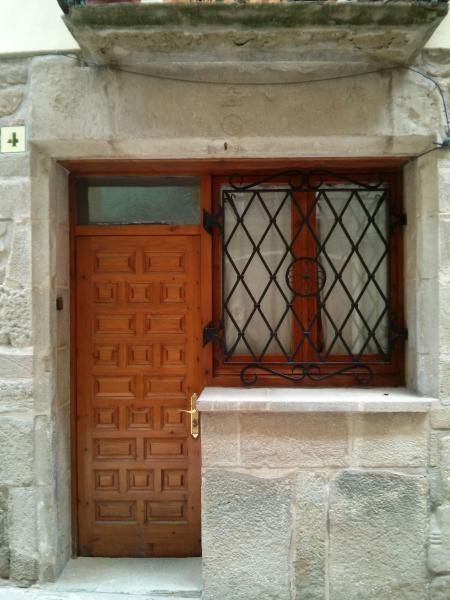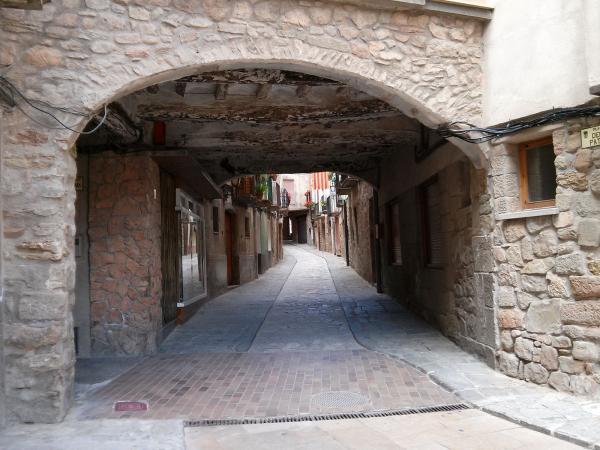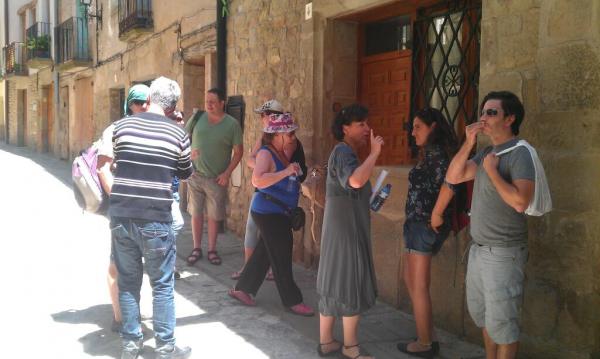
versió per imprimir
El call Jueu de Torà
Noticia
<< Tornar divendres, 13 de Juny de 2014 Torà Autor: editor Al barri jueu s'hi establí el primer comerç de la vila
Cliqueu a les imatges per ampliar-les




Detall d'antiga botiga jueva
Autor: Ramon Sunyer
Autor: Ramon Sunyer

Portal del carrer Nou
Autor: Ramon Sunyer
Autor: Ramon Sunyer

Tour Operadors Israelians visiten el Call Jueu de Torà
Autor: Turisme Segarra
Autor: Turisme Segarra
L'antic call jueu de Torà es localitza a l’actual carrer Nou, en ple nucli antic de la població. S’hi accedeix per dos portals, un de situat a la plaça de l’església i pel portal Nou, amb entrada per la plaça del Pati. És envoltat de petites places, carrers estrets i carrerons de fort pendent, que recreen l’ambient de l’antiga vila medieval.
Al barri jueu toranès s'hi establí el primer comerç de la vila. En donen fe les entrades d’algunes cases que encara conserven la tipologia pròpia de les botigues medievals jueves, amb l’accés a l’esquerra i el taulell a la dreta de la façana per servir els clients des de dintre de la botiga.
Les llindes de moltes cases són també un valuós testimoni material de la presència dels jueus a la població; en alguns casos encara tenen gravat el símbol de Jesús, sigla segons alguns historiadors dels jueus conversos, a més de la data i el nom del propietari.
Residiren al call famílies benestants de la població, com el baró de Morrocurt, els Mujal o els Aldabó, aquests darrers fundadors amb els seus donatius de la botiga del blat o dels pobres i de l'hospital de la vila.
The old Jewish quarter of Torà(la Segarra)is located in what is now Carrer Nou, in the very centre of the old part of the village. Access to this area is through two portals. One is located in the Plaça de l’Església and the Portal Nou provides entry from the Plaça del Pati. This area is surrounded by small squares, narrow streets and very steep alleys that help recreate the atmosphere of the medieval village.
Close by, we find the old bakery, which now houses the bread museum. The first businesses of Torà were established in its Jewish quarter We know this from the entrances to some of the houses that still maintain the specific typology of the medieval Jewish shops, with the entrance on the left and the counter on the right of the facade for serving clients from inside the shop.The lintels of many houses also serve as valuable material witnesses to the presence of the Jewish population. Some houses still bear the engraved symbol of Christ with the date and name of the owner. According to some historians, this identified Jews who had converted to Christianity.
A number of wealthy families lived in the Jewish quarter of the village, including the Baron of Morrocurt, and the Mujal and Aldabó families. The donations of the latter served to set up the wheat shop or “poor people’s shop” and the village Hospital.
Font: Ara LLeida + info (enllaç extern)
Al barri jueu toranès s'hi establí el primer comerç de la vila. En donen fe les entrades d’algunes cases que encara conserven la tipologia pròpia de les botigues medievals jueves, amb l’accés a l’esquerra i el taulell a la dreta de la façana per servir els clients des de dintre de la botiga.
Les llindes de moltes cases són també un valuós testimoni material de la presència dels jueus a la població; en alguns casos encara tenen gravat el símbol de Jesús, sigla segons alguns historiadors dels jueus conversos, a més de la data i el nom del propietari.
Residiren al call famílies benestants de la població, com el baró de Morrocurt, els Mujal o els Aldabó, aquests darrers fundadors amb els seus donatius de la botiga del blat o dels pobres i de l'hospital de la vila.
The old Jewish quarter of Torà
The old Jewish quarter of Torà(la Segarra)is located in what is now Carrer Nou, in the very centre of the old part of the village. Access to this area is through two portals. One is located in the Plaça de l’Església and the Portal Nou provides entry from the Plaça del Pati. This area is surrounded by small squares, narrow streets and very steep alleys that help recreate the atmosphere of the medieval village.
Close by, we find the old bakery, which now houses the bread museum. The first businesses of Torà were established in its Jewish quarter We know this from the entrances to some of the houses that still maintain the specific typology of the medieval Jewish shops, with the entrance on the left and the counter on the right of the facade for serving clients from inside the shop.The lintels of many houses also serve as valuable material witnesses to the presence of the Jewish population. Some houses still bear the engraved symbol of Christ with the date and name of the owner. According to some historians, this identified Jews who had converted to Christianity.
A number of wealthy families lived in the Jewish quarter of the village, including the Baron of Morrocurt, and the Mujal and Aldabó families. The donations of the latter served to set up the wheat shop or “poor people’s shop” and the village Hospital.
Font: Ara LLeida + info (enllaç extern)
Home page | Realització: cdnet